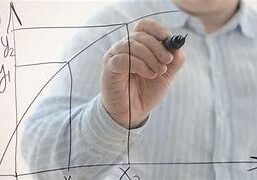Our Algebra 1 Lessons for Grade Students
Algebra 1 Scope and Sequence
Students will be able to:
- Determine the slope of a line given a table of values, the coordinates of two points on the line, or an equation in slope-intercept form.
- Write and solve equations involving direct variation.
- Write linear equations in slope-intercept form given a table of values or a verbal description.
- Decide whether relations represented verbally, tabularly, graphically, and symbolically define a function.
- Evaluate functions, expressed in function notation, given one or more elements in their domains.
- Determine the domain and range of a linear function in mathematical problems, and represent domain and range using inequalities.
- Determine reasonable domain and range values for real-world situations, both continuous and discrete.
Suggested Activities
- Models, Models
- Bouncing Ball
- Mathman on the Slopes
- Walk It!
- The Concorde and a Bike Race
- Guess My Coefficient
- The Prom Project
- Slope-Intercept in Real Life
- This is the Way We Vary
Students will be able to:
- Graph linear functions on the coordinate plane and identify key features, including x-intercept, y-intercept, zeros, and slope, in mathematical and real-world problems.
- Determine the effects on the graph of the parent function f(x) = x when f(x) is replaced by af(x), f(x) + d, f(x - c), f(bx) for specific values of a, b, c, and d.
- Calculate the rate of change of a linear function represented tabularly, graphically, or algebraically in context of mathematical and real-world problems.
Suggested Activities
- As Time Goes By
- The Wave
- Representing Functions
- Shark Attack
Students will be able to:
- Solve linear equations in one variable, including those for which the application of the distributive property is necessary and for which variables are included on both sides.
- Write linear equations in two variables in various forms, including y = mx + b, Ax + By = C, and y - y1 = m(x - x1), given one point and the slope and given two points.
- Determine the slope of a line given a graph or an equation written in various forms, including Ax + By = C, and y - y1 = m(x - x1).
- Write the equation of a line that contains a given point and is parallel to a given line.
- Write the equation of a line that contains a given point and is perpendicular to a given line.
- Write an equation of a line that is parallel or perpendicular to the X or Y axis and determine whether the slope of the line is zero or undefined.
Suggested Activities
- Oh, The Pressure!
- Points, Lines and Slopes-Oh My!
- Linear Functions Here and There
- Linear Equations Art Project
Students will be able to:
- Write systems of two linear equations given a table of values, a graph, or a verbal description.
- Graph systems of two linear equations in two variables on the coordinate plane and determine the solutions if they exist.
- Estimate graphically the solutions to systems of two linear equations with two variables in real-world problems.
- Solve systems of two linear equations with two variables for mathematical and real-world problems.
Suggested Activities
- How You Gonna Call?
- Ready Copy
- How Many Solutions to a System?
- Understanding Solutions of Systems
- Let’s Be Systematic
Students will be able to:
- Solve linear inequalities in one variable, including those for which the application of the distributive property is necessary and for which variables are included on both sides.
- Write linear inequalities in two variables given a table of values, a graph, or a verbal description.
- Graph the solution set of systems of two linear inequalities in two variables on the coordinate plane.
- Solve mathematic and scientific formulas, and other literal equations, for a specified variable.
Suggested Activities
- Applications of Linear Inequalities
- One Variable Linear Inequalities
- Inequalities Foldable/Scavenger Hunt
- Working Teen
- Literal Equations Practice
Students will be able to:
- Calculate, using technology, the correlation coefficient between two quantitative variables and interpret this quantity as a measure of the strength of the linear association.
- Compare and contrast association and causation in real-world problems.
- Write, with and without technology, linear functions that provide a reasonable fit to data to estimate solutions and make predictions for real-world problems.
Suggested Activities
- Monopoly and Line of Best Fit
- Trashcan Bball and Line of Best Fit
- Correlation Investigation
- Correlation Practice
Students will be able to:
- Add and subtract polynomials of degree one and degree two.
- Multiply polynomials of degree one and degree two.
- Divide polynomials of degree one and two.
- Rewrite polynomial expressions of degree one and degree two in equivalent forms using the distributive property;
- Factor, if possible, trinomials with real factors in the form ax2 + bx + c, including perfect square trinomials of degree two.
- Decide if a binomial can be written as the difference of two squares and, if possible, rewrite the binomial as two factors.
Suggested Activities
- Multiplying-Box Method
- Factoring-Box Method
- Number Tricks
- Operations with Polynomials Scavenger Hunt
Students will be able to:
- Identify terms of arithmetic and geometric sequences when the sequences are given in recursive or explicit form.
- Write a formula for the nth term of arithmetic and geometric sequences, given the value of several of their terms.
Suggested Activities
- Introduction to Arithmetic and Geometric Sequences
- Generating Sequences Numerically
- Arithmetic and Geometric Sequences Maze
- Sequences Scavenger Hunt
- Sequences Practice-Mixed
Students will be able to:
- Simplify numeric and algebraic expressions using the laws of exponents, including integral and rational exponents.
- Simplify numerical radical expressions involving square roots.
Suggested Activities
- Exponent Rules Investigation
- Exponent Rules Calculator Exploration
- Exponent Rules Puzzle
- Negative Exponents Number Line Game
- Simplifying Rational Exponents Error Detection
- Simplifying Radicals Maze
Students will be able to:
- Determine the domain and range of quadratic functions and represent the domain and range using inequalities;
- Write equations of quadratic functions given the vertex and another point on the graph, write the equation in vertex form (f(x) = a(x - h)2+ k), and rewrite the equation from vertex form to standard form (f(x) = ax2+ bx + c.)
- Write quadratic functions when given real solutions and graphs of their related equations.
- Graph quadratic functions on the coordinate plane and use the graph to identify key attributes, if possible, including x-intercept, y-intercept, zeros, maximum value, minimum values, vertex, and the equation of the axis of symmetry.
- Describe the relationship between the linear factors of quadratic expressions and the zeros of their associated quadratic functions.
- Determine the effects on the graph of the parent function f(x) = x2 when f(x) is replaced by af(x), f(x) + d, f(x - c), f(bx) for specific values of a, b, c, and d.
- Solve quadratic equations having real solutions by factoring, taking square roots, completing the square, and applying the quadratic formula.
- Write, using technology, quadratic functions that provide a reasonable fit to data to estimate solutions and make predictions for real-world problems.
Suggested Activities
- What Goes Up Must Come Down
- Getting to Know Parabolas
- Ball Toss
- Graphing Quadratic Functions
- Manual Fit – Parabolas
- Quadratic Graphs 3 Forms
- Rectangles and Quadratics
- Applications of Quadratic Functions
Students will be able to:
- Determine the domain and range of exponential functions of the form f(x) = abx and represent the domain and range using inequalities.
- Interpret the meaning of the values of a and b in exponential functions of the form f(x) = abx in real-world problems.
- Write exponential functions in the form f(x) = abx (where b is a rational number) to describe problems arising from mathematical and real-world situations, including growth and decay.
- Graph exponential functions that model growth and decay and identify key features, including y-intercept and asymptote, in mathematical and real-world problems.
- Write, using technology, exponential functions that provide a reasonable fit to data and make predictions for real-world problems.
Suggested Activities
- Growing Money, Shrinking Value
- Last Man Standing
- Spreading Doom
- Do You Want to Be a Millionaire?
- Exponential Functions Matching Game




